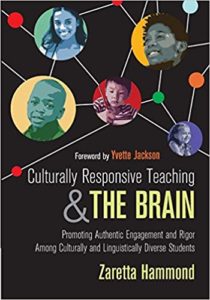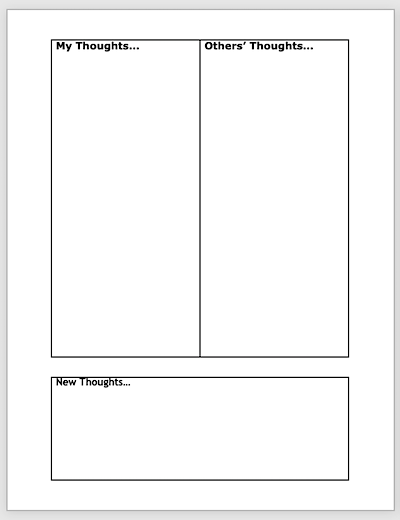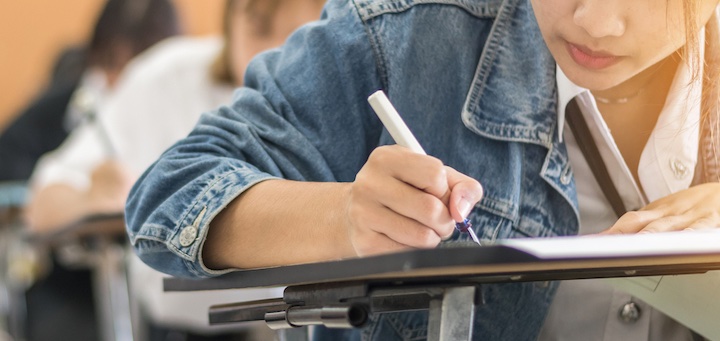A Brain-Based Solution to Student Note-Taking
By Allison Paludi

“Take notes on what’s important.”
“As you read, jot down what you learned.”
Three very vague directions that I am guilty of saying to 11- and 12-year-olds. Countless packets printed with fill-in-the-blanks. Or a blank piece of paper with a giant “space for notes” across the top. Does any of this work?!
It wasn’t until this past year that I fully grappled with the question: How do I help my students take really good notes?
In high school I remember copying word for word from the projector slides. In college my very first class didn’t have a projector. Thus, no slides to copy. Didn’t even have a handout. Just a textbook. My own notebook. And pen and highlighter – wasn’t sure which one to use.
I couldn’t tell you what was even said during those lectures. I sure did write a whole bunch of things down though – racing my pen to paper to capture everything my professor uttered. Yet, to this day, I couldn’t name one fact from that course. For sure, not sticky at all.
My search for stickiness
So now here I am, trying to make material “stick” for my middle schoolers. From my first year using the “Cloze Notes” fill-in-the-blank strategy to the even more vague “Jot down what’s important,” I always grappled with how to foster note taking strategies that truly do work. How do I get middle schoolers to actually make sense of material presented to them?
I began modeling shorthand notes – repeating, “Your notes need to be short and make sense to you.” Yet, although this may be helpful for my students reading at or above grade level (as well as students with faster processing times), how could I reach the majority of my class – students 1-2 years behind some classmates and those who needed more time to reflect?
How would I get them to draw their own conclusions, grapple with content, and ultimately be able to engage in critical discourse based on their notes?
I thought, maybe the “space for notes” sheet in the packet is too vague. Maybe we switch to composition notebooks. Maybe I give them handouts. Indeed, I was at a standstill. None of these methods seemed to help things stick – to really showcase students learning and not just regurgitating.
Landing on Hammond and Harvard
So I went back to the drawing board. Like any teacher attempting to “reteach” a standard or skill, I needed to better understand how our brains truly process before I went and put yet another note taking strategy in front of my students.

How was I igniting my students prior learning with our daily material? How did I chunk it into bite-sized pieces for them to wrestle with? How (and where) could they practice this skill – the chewing? And finally, how could they apply this in new contexts (review).
From Hammond to Harvard: Harvard Graduate School of Education developed Project Zero, whose “mission is to understand and nurture human potentials – such as learning, thinking, ethics, intelligence and creativity – in all human beings.” Through exploration of their website and the plethora of “Thinking Routines,” I came across this one: “I used to think…Now I think.”

Finding the answer in rejiggered T charts

They also had to jot down at least 3 statements from their peers during a discussion. At the end of the lesson, before they began their “Exit Ticket,” they would then return to New Thoughts to see if their original opinions had changed – the final review stage.
The Result (!)
What started as a mere way to switch up what note taking looked like turned into some of the most fruitful interactions around literature I’ve witnessed.
In addition, our daily discussions were truly rich – from critiquing which piece of evidence was chosen to providing counter-claims. Students felt empowered to discuss because they had the chance to grapple with the material first.
In the spirit of these new-found thinking routines, coupled with Hammond’s study of how the brain learns, I was able to reach various kinds of learners, processors, and thinkers.
By the end of our unit, students who never used to voluntarily participate were raising their hands and they were confident in their statements. They were fully engaged in critical discourse furthering their literacy skills.
By the end of the school year, I didn’t have to model how to take really great notes. T charts were made, discussions were had, and strong paragraphs were written as a result. We had truly deepened learning.
We’re left with three questions
Hammond and Harvard have left a permanent imprint on my classroom practice. If our goal is to foster critical and independent thinking, then our questions need to be: How are we modeling? How are we providing space for practice? And, ultimately, How are we giving students the real opportunity to be the drivers of their learning?
Allison Paludi is in her seventh year in education. She is currently the 6th Grade ELA teacher at Great Oaks Legacy Charter School in Newark, New Jersey. At her campus she helped establish PLCs with her ELA Department as well as lead the 5th and 6th grade level teams.
Read another MiddleWeb article by Allison: 3 Reasons I’m Using a Chatbot in My Classes.






































I can see how this notetaking approach would be very effective for thinking, discussion, and reflection. The term “thoughts” is open-ended, simple to understand, and shows the metacognition process that we all go through in any situation, not just when taking notes. Differentiation is built-in as well as honor for individual thoughts as well as others’ thoughts. This approach would work very well in middle school social studies classes.
I think I agree, especially with your last statement. But I’m struggling to see using it in my math classes. Asking kids for what they “used to think” about ratios is not going to produce much harvest, it seems to me. I’m not discounting this entirely, but I’d like to see more. I do think I should read Hammond’s book, which I’ll order today.